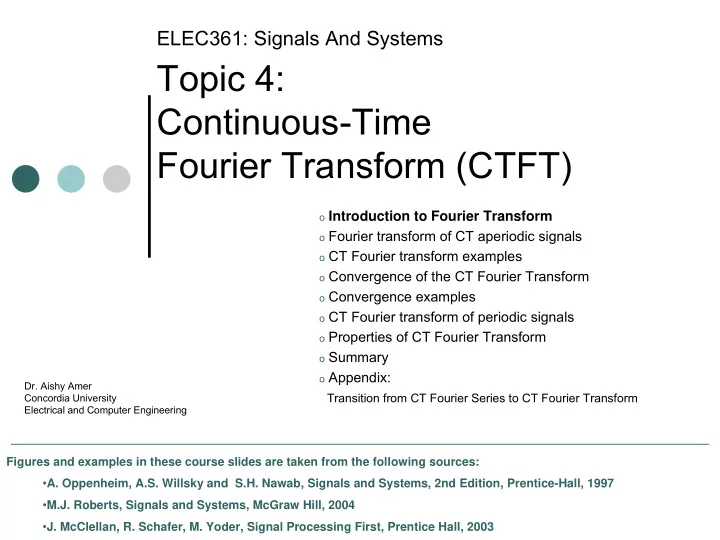

Fourier Transform of Periodic Signal: Example 6.1 44
Fourier Transform of Periodic Signal: Example 6.1 � This example shows the reveres effect in the time and frequency domains in terms of the width of the time signal and the corresponding Fourier transform 45
Fourier Transform of Periodic Signal: Example 6.1 46
Fourier transform for periodic signals: Example 6.2 47
Fourier transform for periodic signals: Example 6.2 48
Fourier transform for periodic signals: Example 6.2 The periodic impulse train and its Fourier transform are very useful in the analysis of sampling systems 49
Fourier Transform of Periodic Signals: Example 50
Outline Introduction to Fourier Transform � Fourier transform of CT aperiodic signals � Fourier transform examples � Convergence of the CT Fourier Transform � Convergence examples � Fourier transform of periodic signals � Properties of CT Fourier Transform � Summary � Appendix � Transition: CT Fourier Series to CT Fourier Transform � 51
Properties of the CT Fourier Transform � The properties are useful in determining the Fourier transform or inverse Fourier transform � They help to represent a given signal in term of operations (e.g., convolution, differentiation, shift) on another signal for which the Fourier transform is known ⇔ � Operations on {x(t)} Operations on {X(j ω )} � Help find analytical solutions to Fourier transform problems of complex signals � Example: = − → t FT { y ( t ) a u ( t 5 ) } delay and multiplica tion 52
Properties of the CT Fourier Transform � The properties of the CT Fourier transform are very similar to those of the CT Fourier series � Consider two signals x(t) and y(t) with Fourier transforms X(j ω ) and Y(j ω ), respectively (or X(f) and Y(f)) � The following properties can easily been shown using 53
Properties of the CT Fourier Transform 54
Properties of the CT Fourier Transform 55
Properties of the CT Fourier Transform 56
Properties of the CT Fourier Transform 57
Properties of the CT Fourier Transform 58
Properties of the CT Fourier Transform � The time and frequency scaling properties indicate that if a signal is expanded in one domain it is compressed in the other domain. This is also called the “uncertainty principle” of Fourier analysis 59
Properties of the CT Fourier Transform 60
Properties of the CT Fourier: Time Shifting & Scaling: Example 61
Properties of the CT Fourier: Time Shifting & Scaling: Example 62
Properties of the CT Fourier Transform 63
Properties of the CT Fourier Transform 64
Properties of the CT Fourier Transform 65
Properties of the CT Fourier Transform 66
Properties of the CT Fourier Transform: Example 6.4 67
Properties of the CT Fourier Transform: Differentiation Property Example 68
Properties of the CT Fourier Transform: Examples 6.5 & 6.6 69
Properties of the CT Fourier Transform: Differentiation Property Example 70
Properties of the CT Fourier Transform: Differentiation Property: Example 71
Properties of the CT Fourier Transform 72
Properties of the CT Fourier Transform Multiplication Convolution Duality Proof 73
Properties of the CT Fourier Transform 74
Properties of the CT Fourier Transform: Convolution Property Example 75
Properties of the CT Fourier Transform 76
Properties of the CT Fourier Transform: Differential Equations 77
Properties of the CT Fourier Transform: Differential Equation Example 6.8 78
Properties of the CT Fourier Transform: Modulation Property: Example 79
Properties of the CT Fourier Transform 80
Properties of the CT Fourier Transform 81
Properties of the CT Fourier Transform: Integration Property 82
Properties of the CT Fourier Transform: Integration Property: Example 83
Properties of the CT Fourier Transform 84
Properties of the CT Fourier Transform: Area Property: Example 85
Properties of the CT Fourier Transform: Area Property: Example 86
Properties of the CT Fourier Transform: Area Property: Example 87
Properties of the CT Fourier Transform 88
Properties of the CT Fourier Transform 89
Properties of the CT Fourier Transform: Example 6.4 90
Properties of the CT Fourier Transform: Duality Property: Example 91
Outline Introduction to Fourier Transform � Fourier transform of CT aperiodic signals � Fourier transform examples � Convergence of the CT Fourier Transform � Convergence examples � Fourier transform of periodic signals � Properties of CT Fourier Transform � Summary � Appendix � Transition: CT Fourier Series to CT Fourier Transform � 92
CTFT: Summary 93
Summary of CTFT Properties 94
Summary of CTFT Properties 95
CTFT: Summary of Pairs 96
CTFT: Summary of Pairs 97
Outline Introduction to Fourier Transform � Fourier transform of CT aperiodic signals � Fourier transform examples � Convergence of the CT Fourier Transform � Convergence examples � Fourier transform of periodic signals � Properties of CT Fourier Transform � Summary � Appendix � Transition: CT Fourier Series to CT Fourier Transform � 98
Transition: CT Fourier Series to CT Fourier Transform 99
Transition: CT Fourier Series to CT Fourier Transform � Below are plots of the magnitude of X[ k ] for 50% and 10% duty cycles � As the period increases the sinc function widens and its magnitude falls � As the period approaches infinity, the CT Fourier Series harmonic function becomes an infinitely-wide sinc function with zero amplitude (since X(k) is divided by T o ) 100
Recommend
More recommend